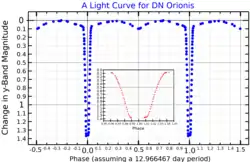 A near-infrared (y band) light curve for DN Orionis. The main plot shows the variation over a full orbital period, and the inset plot shows the time near maximum eclipse. Adapted from Etzel and Olson (1995)[1] | |
| Observation data Epoch J2000 Equinox J2000 | |
|---|---|
| Constellation | Orion |
| Right ascension | 06h 00m 28.34516s[2] |
| Declination | 10° 13′ 04.9963″[2] |
| Apparent magnitude (V) | 9.18[3] |
| Characteristics | |
| Spectral type | A0 + G5III[4] |
| B−V color index | 0.240±0.026[3] |
| Astrometry | |
| Proper motion (μ) | RA: −1.771 mas/yr[2] Dec.: −7.243 mas/yr[2] |
| Parallax (π) | 1.9058 ± 0.0452 mas[2] |
| Distance | 1,710 ± 40 ly (520 ± 10 pc) |
| Absolute magnitude (MV) | 0.19 + 0.86[1] |
| Orbit[5] | |
| Period (P) | 12.9663 d |
| Eccentricity (e) | 0.00 |
| Periastron epoch (T) | 2,428,494.55±10.0 JD |
| Semi-amplitude (K1) (primary) | 8.2 km/s |
| Semi-amplitude (K2) (secondary) | 120.4 km/s |
| Details | |
| Primary | |
| Mass | 2.80±0.05[1] M☉ |
| Radius | 2.36±0.07[1] R☉ |
| Luminosity | 50[1] L☉ |
| Surface gravity (log g) | 4.14 cgs |
| Secondary | |
| Mass | 0.34±0.10[1] M☉ |
| Radius | 6.66±0.15[1] R☉ |
| Luminosity | 25[1] L☉ |
| Surface gravity (log g) | 2.31 cgs |
| Other designations | |
| Database references | |
| SIMBAD | data |
DN Orionis is an Algol variable[7] located in the constellation of Orion. The primary star is a spectral type A0 star and the secondary is an evolved giant star of type G5III.[4] The pair form a classical Algol-type system in which each star eclipses the other once per orbit, dropping the visual magnitude from 9.14 down to 9.62 at primary minimum and 9.25 at secondary minimum.[7] Their orbital period is close to 13 days long.[5]
This is a slightly detached system in which the secondary is almost in contact with its Roche limit, while the primary has an accretion disk that is creating emission lines in its spectrum.[4] The pair have an unusually low mass ratio and the secondary appears to be of very low mass and overluminous.[5] Mass is flowing from the extended atmosphere of the cooler secondary to the hotter primary.[1] An evolutionary history of this system suggests that the current secondary was once the primary component, but has since transferred most of its mass to the partner star as it evolved off the main sequence.[4]
References
- 1 2 3 4 5 6 7 8 9 Etzel, Paul B.; Olson, Edward C. (October 1995). "DN Orionis: A Long-Period Mass-Transferring "Slightly Detached" Algol Binary". Astronomical Journal. 110: 1809. Bibcode:1995AJ....110.1809E. doi:10.1086/117652.
- 1 2 3 4 5 Brown, A. G. A.; et al. (Gaia collaboration) (August 2018). "Gaia Data Release 2: Summary of the contents and survey properties". Astronomy & Astrophysics. 616. A1. arXiv:1804.09365. Bibcode:2018A&A...616A...1G. doi:10.1051/0004-6361/201833051. Gaia DR2 record for this source at VizieR.
- 1 2 Anderson, E.; Francis, Ch. (2012). "XHIP: An extended hipparcos compilation". Astronomy Letters. 38 (5): 331. arXiv:1108.4971. Bibcode:2012AstL...38..331A. doi:10.1134/S1063773712050015. S2CID 119257644.
- 1 2 3 4 Eggleton, Peter P.; Kiseleva-Eggleton, Ludmila (August 2002). "The Evolution of Cool Algols". The Astrophysical Journal. 575 (1): 461–473. arXiv:astro-ph/0209201. Bibcode:2002ApJ...575..461E. doi:10.1086/341215. S2CID 10297620.
- 1 2 3 Smak, Józef (1964). "DN Orionis". Publications of the Astronomical Society of the Pacific. 76 (451): 210. Bibcode:1964PASP...76..210S. doi:10.1086/128087.
- ↑ "DN Ori". SIMBAD. Centre de données astronomiques de Strasbourg. Retrieved 2021-11-15.
- 1 2 Avvakumova, E. A.; et al. (October 2013). "Eclipsing variables: Catalogue and classification". Astronomische Nachrichten. 334 (8): 860. Bibcode:2013AN....334..860A. doi:10.1002/asna.201311942. hdl:10995/27061.